engine coolant Seat Ibiza 5D 2006 User Guide
[x] Cancel search | Manufacturer: SEAT, Model Year: 2006, Model line: Ibiza 5D, Model: Seat Ibiza 5D 2006Pages: 268, PDF Size: 8.14 MB
Page 160 of 268
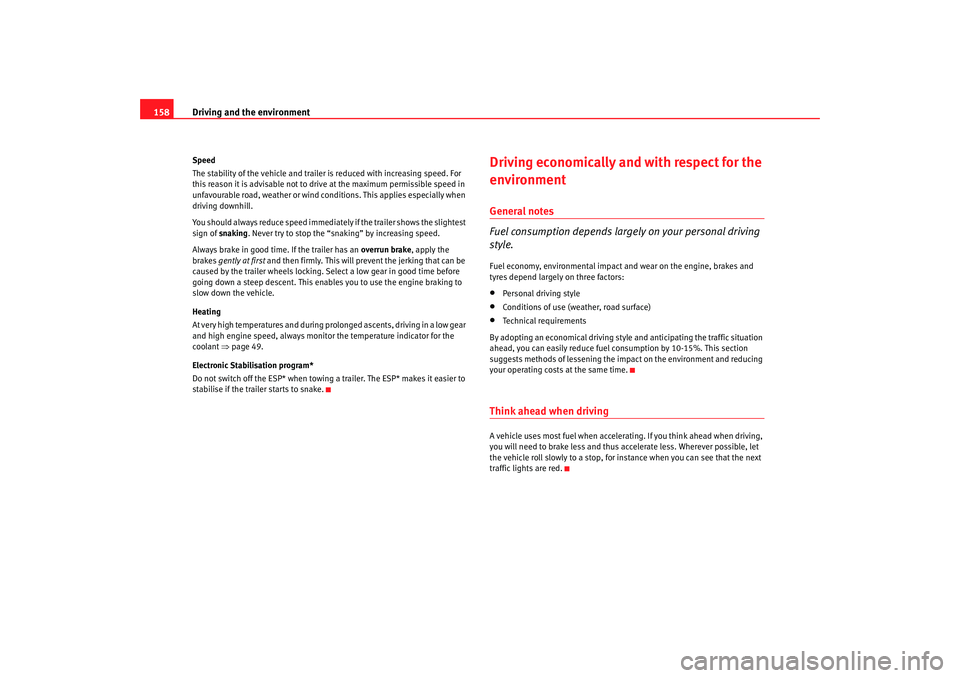
Driving and the environment
158Speed
The stability of the vehicle and trailer is reduced with increasing speed. For
this reason it is advisable not to drive at the maximum permissible speed in
unfavourable road, weather or wind conditions. This applies especially when
driving downhill.
You should always reduce speed immediately if the trailer shows the slightest
sign of snaking . Never try to stop the “snaking” by increasing speed.
Always brake in good time. If the trailer has an overrun brake, apply the
brakes gently at first and then firmly. This will pr event the jerking that can be
caused by the trailer wheels locking. Select a low gear in good time before
going down a steep descent. This enables you to use the engine braking to
slow down the vehicle.
Heating
At very high temperatures and during prolonged ascents, driving in a low gear
and high engine speed, always monitor the temperature indicator for the
coolant ⇒page 49.
Electronic Stabilisation program*
Do not switch off the ESP* when towing a trailer. The ESP* makes it easier to
stabilise if the trailer starts to snake.
Driving economically and with respect for the
environmentGeneral notes
Fuel consumption depends largely on your personal driving
style.Fuel economy, environmental impact and wear on the engine, brakes and
tyres depend largely on three factors:•
Personal driving style
•
Conditions of use (weather, road surface)
•
Technical requirements
By adopting an economical driving style and anticipating the traffic situation
ahead, you can easily reduce fuel consumption by 10-15%. This section
suggests methods of lessening the impact on the environment and reducing
your operating costs at the same time.
Think ahead when drivingA vehicle uses most fuel when accelerating. If you think ahead when driving,
you will need to brake less and thus accelerate less. Wherever possible, let
the vehicle roll slowly to a stop, for instance when you can see that the next
traffic lights are red.
ibiza_angles_0706_DEF Seite 158 Freitag, 1. September 2006 1:18 13
Page 178 of 268
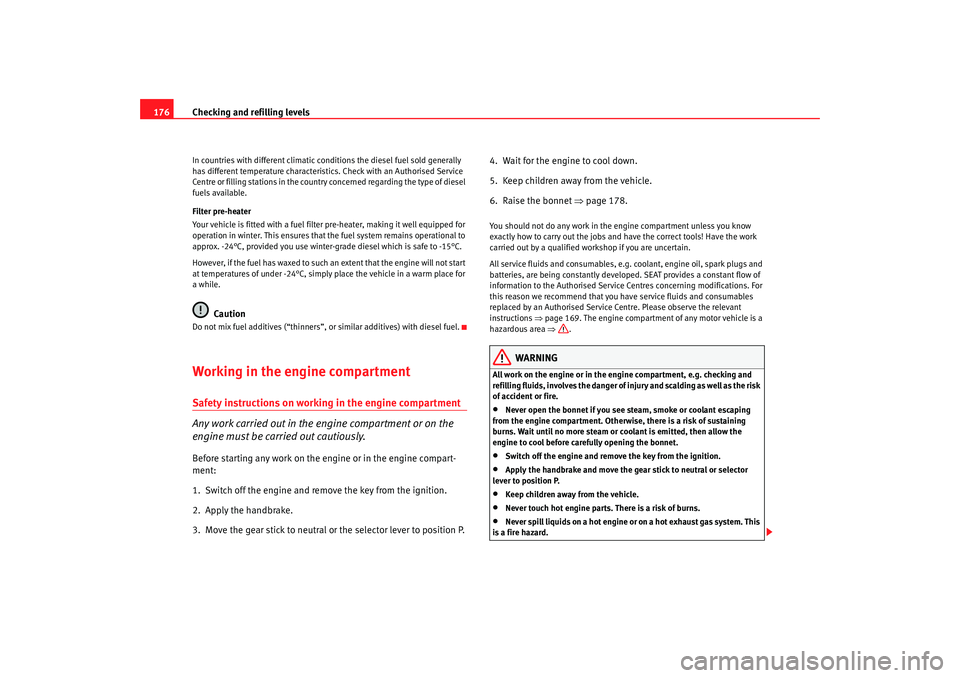
Checking and refilling levels
176In countries with different climatic conditions the diesel fuel sold generally
has different temperature characteristics. Check with an Authorised Service
Centre or filling stations in the country concerned regarding the type of diesel
fuels available.
Filter pre-heater
Your vehicle is fitted with a fuel filter pre-heater, making it well equipped for
operation in winter. This ensures that the fuel system remains operational to
approx. -24°C, provided you use winter-grade diesel which is safe to -15°C.
However, if the fuel has waxed to such an extent that the engine will not start
at temperatures of under -24°C, simply place the vehicle in a warm place for
a while.
Caution
Do not mix fuel additives (“thinners”, or similar additives) with diesel fuel.Working in the engine compartmentSafety instructions on working in the engine compartment
Any work carried out in the engine compartment or on the
engine must be carried out cautiously.Before starting any work on the engine or in the engine compart-
ment:
1. Switch off the engine and remove the key from the ignition.
2. Apply the handbrake.
3. Move the gear stick to neutral or the selector lever to position P. 4. Wait for the engine to cool down.
5. Keep children away from the vehicle.
6. Raise the bonnet
⇒page 178.
You should not do any work in the engine compartment unless you know
exactly how to carry out the jobs and have the correct tools! Have the work
carried out by a qualified workshop if you are uncertain.
All service fluids and consumables, e.g. coolant, engine oil, spark plugs and
batteries, are being constantly developed . SEAT provides a constant flow of
information to the Authorised Service Centres concerning modifications. For
this reason we recommend that you have service fluids and consumables
replaced by an Authorised Service Centre. Please observe the relevant
instructions ⇒page 169. The engine compartmen t of any motor vehicle is a
hazardous area ⇒.
WARNING
All work on the engine or in the engine compartment, e.g. checking and
refilling fluids, involves the danger of injury and scalding as well as the risk
of accident or fire.•
Never open the bonnet if you see steam, smoke or coolant escaping
from the engine compartment. Otherwise, there is a risk of sustaining
burns. Wait until no more steam or coolant is emitted, then allow the
engine to cool before carefully opening the bonnet.
•
Switch off the engine and remove the key from the ignition.
•
Apply the handbrake and move the gear stick to neutral or selector
lever to position P.
•
Keep children away from the vehicle.
•
Never touch hot engine parts. There is a risk of burns.
•
Never spill liquids on a hot engine or on a hot exhaust gas system. This
is a fire hazard.
ibiza_angles_0706_DEF Seite 176 Freitag, 1. September 2006 1:18 13
Page 179 of 268
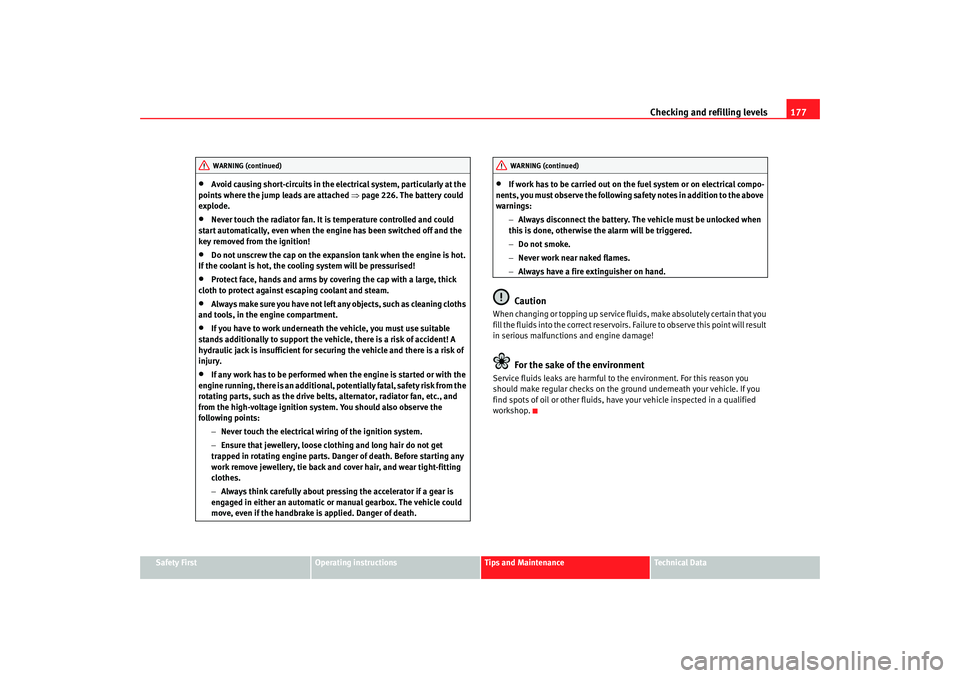
Checking and refilling levels177
Safety First
Operating instructions
Tips and Maintenance
Te c h n i c a l D a t a
•
Avoid causing short-circuits in the electrical system, particularly at the
points where the jump leads are attached ⇒page 226. The battery could
explode.
•
Never touch the radiator fan. It is temperature controlled and could
start automatically, even when the engine has been switched off and the
key removed from the ignition!
•
Do not unscrew the cap on the expansion tank when the engine is hot.
If the coolant is hot, the cooling system will be pressurised!
•
Protect face, hands and arms by covering the cap with a large, thick
cloth to protect against escaping coolant and steam.
•
Always make sure you have not left any objects, such as cleaning cloths
and tools, in the engine compartment.
•
If you have to work underneath the vehicle, you must use suitable
stands additionally to support the vehicle, there is a risk of accident! A
hydraulic jack is insufficient for securing the vehicle and there is a risk of
injury.
•
If any work has to be performed when the engine is started or with the
engine running, there is an additional, pote ntially fatal, safety risk from the
rotating parts, such as the drive belts, alternator, radiator fan, etc., and
from the high-voltage ignition syst em. You should also observe the
following points:
−Never touch the electrical wiring of the ignition system.
− Ensure that jewellery, loose clothing and long hair do not get
trapped in rotating engine parts. Danger of death. Before starting any
work remove jewellery, tie back and cover hair, and wear tight-fitting
clothes.
− Always think carefully about pressing the accelerator if a gear is
engaged in either an automatic or manual gearbox. The vehicle could
move, even if the handbrake is applied. Danger of death.
•
If work has to be carried out on the fuel system or on electrical compo-
nents, you must observe the following sa fety notes in addition to the above
warnings:
−Always disconnect the battery. The vehicle must be unlocked when
this is done, otherwise the alarm will be triggered.
− Do not smoke.
− Never work near naked flames.
− Always have a fire extinguisher on hand.Caution
When changing or topping up service fluids, make absolutely certain that you
fill the fluids into the correct reservoirs. Failure to observe this point will result
in serious malfunctions and engine damage!
For the sake of the environment
Service fluids leaks are harmful to the environment. For this reason you
should make regular checks on the ground underneath your vehicle. If you
find spots of oil or other fluids, have your vehicle inspected in a qualified
workshop.
WARNING (continued)
WARNING (continued)
ibiza_angles_0706_DEF Seite 177 Freitag, 1. September 2006 1:18 13
Page 180 of 268
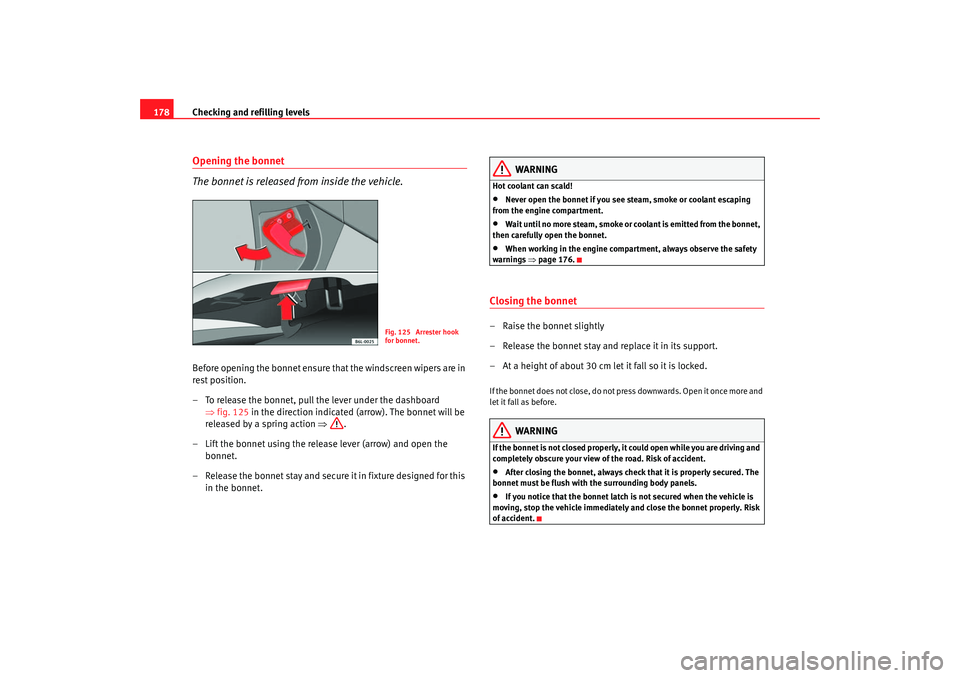
Checking and refilling levels
178Opening the bonnet
The bonnet is released from inside the vehicle.Before opening the bonnet ensure that the windscreen wipers are in
rest position.
– To release the bonnet, pull the lever under the dashboard
⇒fig. 125 in the direction indicated (arrow). The bonnet will be
released by a spring action ⇒.
– Lift the bonnet using the release lever (arrow) and open the bonnet.
– Release the bonnet stay and secure it in fixture designed for this in the bonnet.
WARNING
Hot coolant can scald!•
Never open the bonnet if you see steam, smoke or coolant escaping
from the engine compartment.
•
Wait until no more steam, smoke or coolant is emitted from the bonnet,
then carefully open the bonnet.
•
When working in the engine compartment, always observe the safety
warnings ⇒page 176.
Closing the bonnet–Raise the bonnet slightly
– Release the bonnet stay and replace it in its support.
– At a height of about 30 cm let it fall so it is locked.If the bonnet does not close, do not press downwards. Open it once more and
let it fall as before.
WARNING
If the bonnet is not closed properly, it could open while you are driving and
completely obscure your view of the road. Risk of accident.•
After closing the bonnet, always check that it is properly secured. The
bonnet must be flush with the surrounding body panels.
•
If you notice that the bonnet latch is not secured when the vehicle is
moving, stop the vehicle immediately and close the bonnet properly. Risk
of accident.
Fig. 125 Arrester hook
for bonnet.
ibiza_angles_0706_DEF Seite 178 Freitag, 1. September 2006 1:18 13
Page 185 of 268
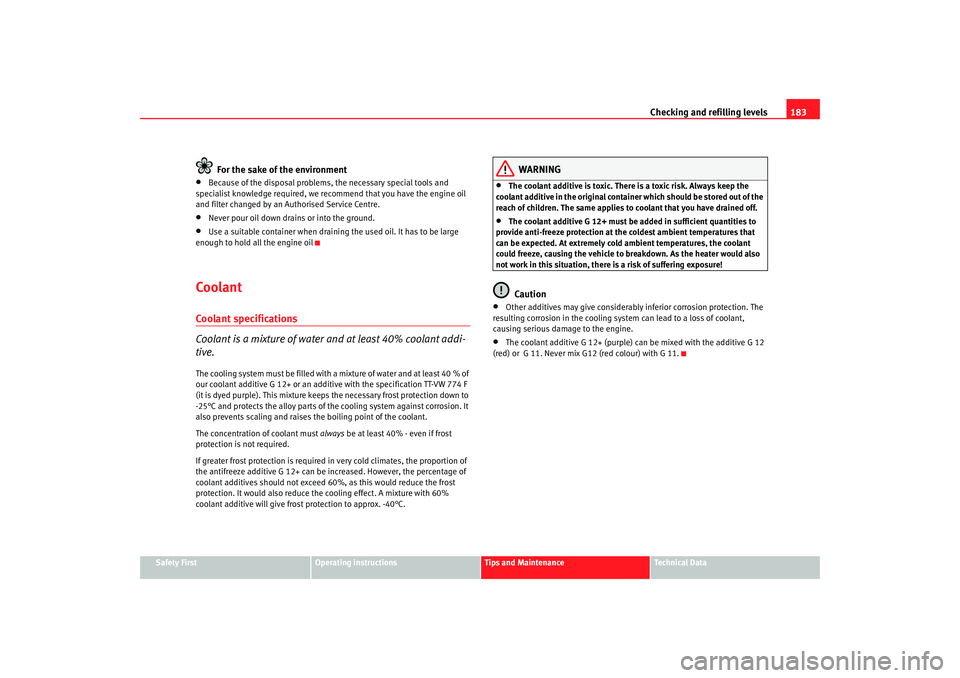
Checking and refilling levels183
Safety First
Operating instructions
Tips and Maintenance
Te c h n i c a l D a t a
For the sake of the environment
•
Because of the disposal problems, the necessa ry special tools and
specialist knowledge required, we reco mmend that you have the engine oil
and filter changed by an Authorised Service Centre.
•
Never pour oil down drains or into the ground.
•
Use a suitable container when draining the used oil. It has to be large
enough to hold all the engine oil
CoolantCoolant specifications
Coolant is a mixture of water and at least 40% coolant addi-
tive.The cooling system must be filled with a mixture of water and at least 40 % of
our coolant additive G 12+ or an additive with the specification TT-VW 774 F
(it is dyed purple). This mixture keeps the necessary frost protection down to
-25°C and protects the alloy parts of th e cooling system against corrosion. It
also prevents scaling and raises the boiling point of the coolant.
The concentration of coolant must always be at least 40% - even if frost
protection is not required.
If greater frost protection is required in very cold climates, the proportion of
the antifreeze additive G 12+ can be increased. However, the percentage of
coolant additives should not exceed 60%, as this would reduce the frost
protection. It would also reduce the cooling effect. A mixture with 60%
coolant additive will give frost protection to approx. -40°C.
WARNING
•
The coolant additive is toxic. There is a toxic risk. Always keep the
coolant additive in the original container which should be stored out of the
reach of children. The same applies to coolant that you have drained off.
•
The coolant additive G 12+ must be added in sufficient quantities to
provide anti-freeze protection at the coldest ambient temperatures that
can be expected. At extremely cold ambient temperatures, the coolant
could freeze, causing the vehicle to breakdown. As the heater would also
not work in this situat ion, there is a risk of suffering exposure!Caution
•
Other additives may give considerably inferior corrosion protection. The
resulting corrosion in the cooling system can lead to a loss of coolant,
causing serious damage to the engine.
•
The coolant additive G 12+ (purple) can be mixed with the additive G 12
(red) or G 11. Never mix G12 (red colour) with G 11.
ibiza_angles_0706_DEF Seite 183 Freitag, 1. September 2006 1:18 13
Page 186 of 268
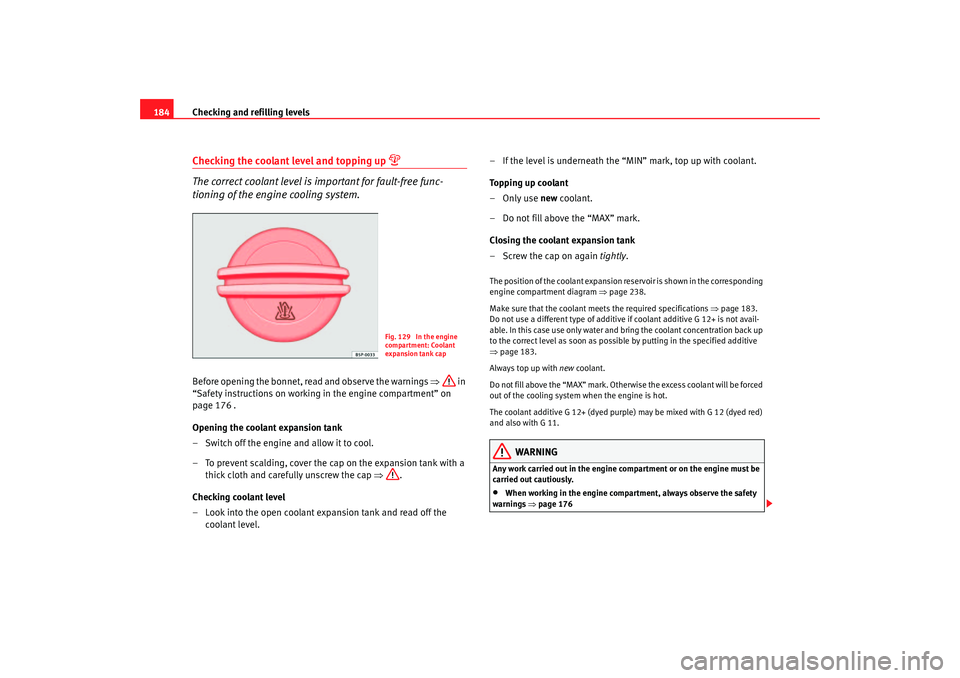
Checking and refilling levels
184Checking the coolant level and topping up
The correct coolant level is important for fault-free func-
tioning of the engine cooling system.Before opening the bonnet, read and observe the warnings ⇒ in
“Safety instructions on working in the engine compartment” on
page 176 .
Opening the coolant expansion tank
– Switch off the engine and allow it to cool.
– To prevent scalding, cover the cap on the expansion tank with a thick cloth and carefully unscrew the cap ⇒.
Checking coolant level
– Look into the open coolant ex pansion tank and read off the
coolant level. – If the level is underneath the “MIN” mark, top up with coolant.
Topping up coolant
–Only use
new coolant.
– Do not fill above the “MAX” mark.
Closing the coolant expansion tank
– Screw the cap on again tightly.
The position of the coolant expansion re servoir is shown in the corresponding
engine compartment diagram ⇒page 238.
Make sure that the coolant meets the required specifications ⇒page 183.
Do not use a different type of additive if coolant additive G 12+ is not avail-
able. In this case use only water and bring the coolant concentration back up
to the correct level as soon as possible by putting in the specified additive
⇒ page 183.
Always top up with new coolant.
Do not fill above the “MAX” mark. Otherwise the excess coolant will be forced
out of the cooling system when the engine is hot.
The coolant additive G 12+ (dyed purple ) may be mixed with G 12 (dyed red)
and also with G 11.
WARNING
Any work carried out in the engine compartment or on the engine must be
carried out cautiously.•
When working in the engine compartment, always observe the safety
warnings ⇒page 176
Fig. 129 In the engine
compartment: Coolant
expansion tank cap
ibiza_angles_0706_DEF Seite 184 Freitag, 1. September 2006 1:18 13
Page 187 of 268
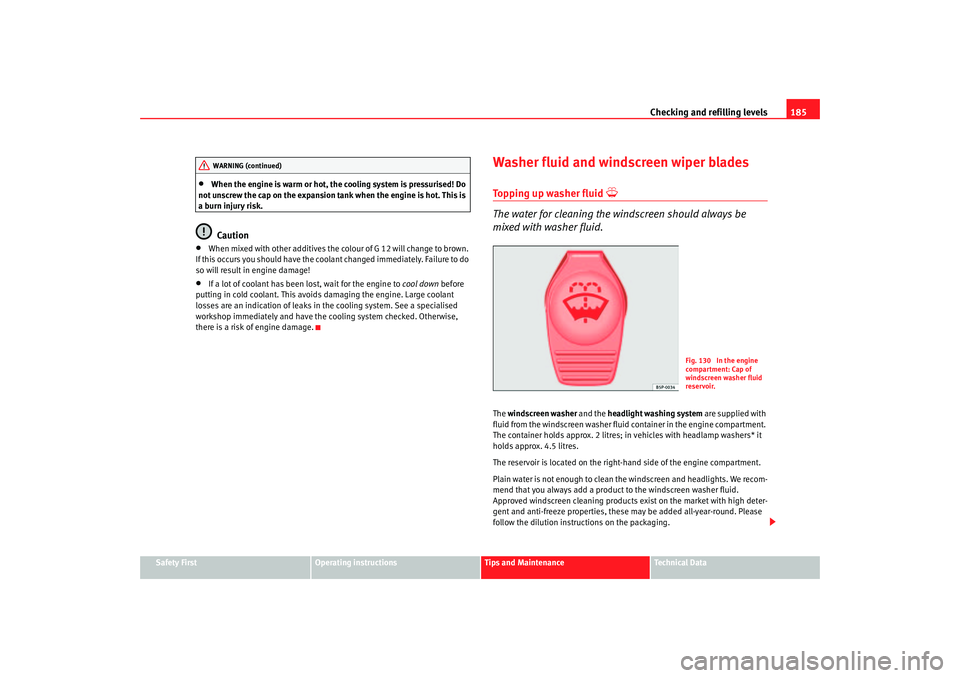
Checking and refilling levels185
Safety First
Operating instructions
Tips and Maintenance
Te c h n i c a l D a t a
•
When the engine is warm or hot, the cooling system is pressurised! Do
not unscrew the cap on the expansion t ank when the engine is hot. This is
a burn injury risk.Caution
•
When mixed with other additives the colour of G 12 will change to brown.
If this occurs you should have the coolant changed immediately. Failure to do
so will result in engine damage!
•
If a lot of coolant has been lost, wait for the engine to cool down before
putting in cold coolant. This avoids damaging the engine. Large coolant
losses are an indication of leaks in the cooling system. See a specialised
workshop immediately and have the c ooling system checked. Otherwise,
there is a risk of engine damage.
Washer fluid and windscreen wiper bladesTopping up washer fluid
The water for cleaning the windscreen should always be
mixed with washer fluid.The windscreen washer and the headlight washing system are supplied with
fluid from the windscreen washer fluid container in the engine compartment.
The container holds approx. 2 litres; in vehicles with headlamp washers* it
holds approx. 4.5 litres.
The reservoir is located on the right-hand side of the engine compartment.
Plain water is not enough to clean th e windscreen and headlights. We recom-
mend that you always add a product to the windscreen washer fluid.
Approved windscreen cleaning products exist on the market with high deter-
gent and anti-freeze properties, these may be added all-year-round. Please
follow the dilution instructions on the packaging.
WARNING (continued)
Fig. 130 In the engine
compartment: Cap of
windscreen washer fluid
reservoir.
ibiza_angles_0706_DEF Seite 185 Freitag, 1. September 2006 1:18 13
Page 261 of 268
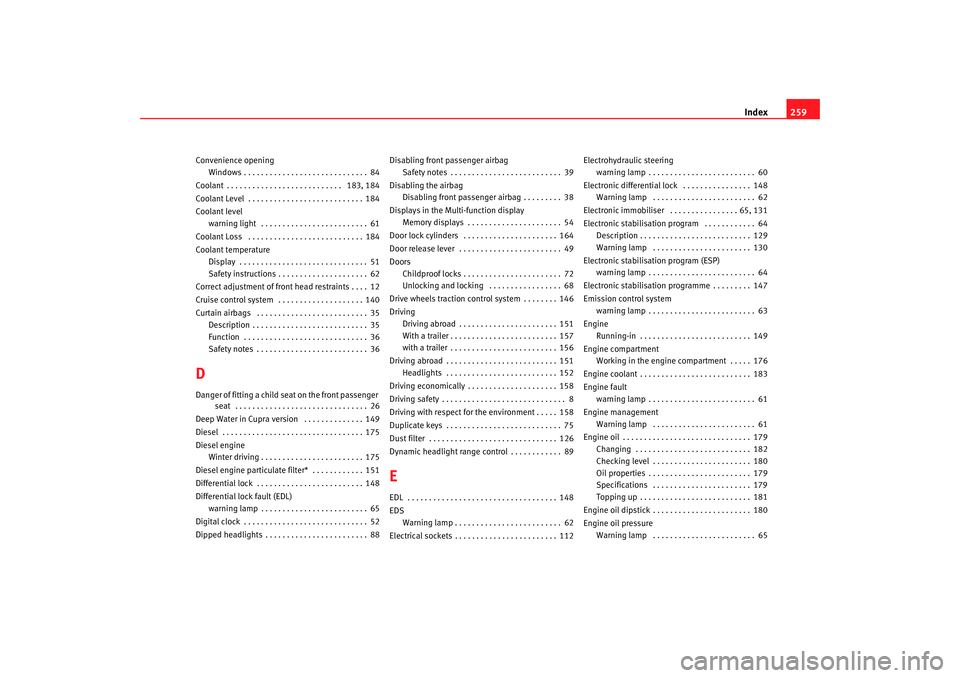
Index259
Convenience opening
Windows . . . . . . . . . . . . . . . . . . . . . . . . . . . . . 84
Coolant . . . . . . . . . . . . . . . . . . . . . . . . . . . 183, 184
Coolant Level . . . . . . . . . . . . . . . . . . . . . . . . . . . 184
Coolant level warning light . . . . . . . . . . . . . . . . . . . . . . . . . 61
Coolant Loss . . . . . . . . . . . . . . . . . . . . . . . . . . . 184
Coolant temperature Display . . . . . . . . . . . . . . . . . . . . . . . . . . . . . . 51
Safety instructions . . . . . . . . . . . . . . . . . . . . . 62
Correct adjustment of front head restraints . . . . 12
Cruise control system . . . . . . . . . . . . . . . . . . . . 140
Curtain airbags . . . . . . . . . . . . . . . . . . . . . . . . . . 35 Description . . . . . . . . . . . . . . . . . . . . . . . . . . . 35
Function . . . . . . . . . . . . . . . . . . . . . . . . . . . . . 36
Safety notes . . . . . . . . . . . . . . . . . . . . . . . . . . 36DDanger of fitting a child seat on the front passenger seat . . . . . . . . . . . . . . . . . . . . . . . . . . . . . . . 26
Deep Water in Cupra version . . . . . . . . . . . . . . 149
Diesel . . . . . . . . . . . . . . . . . . . . . . . . . . . . . . . . . 175
Diesel engine Winter driving . . . . . . . . . . . . . . . . . . . . . . . . 175
Diesel engine particulate filter* . . . . . . . . . . . . 151
Differential lock . . . . . . . . . . . . . . . . . . . . . . . . . 148
Differential lock fault (EDL) warning lamp . . . . . . . . . . . . . . . . . . . . . . . . . 65
Digital clock . . . . . . . . . . . . . . . . . . . . . . . . . . . . . 52
Dipped headlights . . . . . . . . . . . . . . . . . . . . . . . . 88 Disabling front passenger airbag
Safety notes . . . . . . . . . . . . . . . . . . . . . . . . . . 39
Disabling the airbag Disabling front passenger airbag . . . . . . . . . 38
Displays in the Mult i-function display
Memory displays . . . . . . . . . . . . . . . . . . . . . . 54
Door lock cylinders . . . . . . . . . . . . . . . . . . . . . . 164
Door release lever . . . . . . . . . . . . . . . . . . . . . . . . 49
Doors Childproof locks . . . . . . . . . . . . . . . . . . . . . . . 72
Unlocking and locking . . . . . . . . . . . . . . . . . 68
Drive wheels traction control system . . . . . . . . 146
Driving Driving abroad . . . . . . . . . . . . . . . . . . . . . . . 151
With a trailer . . . . . . . . . . . . . . . . . . . . . . . . . 157
with a trailer . . . . . . . . . . . . . . . . . . . . . . . . . 156
Driving abroad . . . . . . . . . . . . . . . . . . . . . . . . . . 151 Headlights . . . . . . . . . . . . . . . . . . . . . . . . . . 152
Driving economically . . . . . . . . . . . . . . . . . . . . . 158
Driving safety . . . . . . . . . . . . . . . . . . . . . . . . . . . . . 8
Driving with respect for the environment . . . . . 158
Duplicate keys . . . . . . . . . . . . . . . . . . . . . . . . . . . 75
Dust filter . . . . . . . . . . . . . . . . . . . . . . . . . . . . . . 126
Dynamic headlight range control . . . . . . . . . . . . 89
EEDL . . . . . . . . . . . . . . . . . . . . . . . . . . . . . . . . . . . 148
EDS Warning lamp . . . . . . . . . . . . . . . . . . . . . . . . . 62
Electrical sockets . . . . . . . . . . . . . . . . . . . . . . . . 112 Electrohydraulic steering
warning lamp . . . . . . . . . . . . . . . . . . . . . . . . . 60
Electronic differential lock . . . . . . . . . . . . . . . . 148 Warning lamp . . . . . . . . . . . . . . . . . . . . . . . . 62
Electronic immobiliser . . . . . . . . . . . . . . . . 65, 131
Electronic stabilisation program . . . . . . . . . . . . 64 Description . . . . . . . . . . . . . . . . . . . . . . . . . . 129
Warning lamp . . . . . . . . . . . . . . . . . . . . . . . 130
Electronic stabilisation program (ESP) warning lamp . . . . . . . . . . . . . . . . . . . . . . . . . 64
Electronic stabilisation programme . . . . . . . . . 147
Emission control system warning lamp . . . . . . . . . . . . . . . . . . . . . . . . . 63
Engine Running-in . . . . . . . . . . . . . . . . . . . . . . . . . . 149
Engine compartment Working in the engine compartment . . . . . 176
Engine coolant . . . . . . . . . . . . . . . . . . . . . . . . . . 183
Engine fault warning lamp . . . . . . . . . . . . . . . . . . . . . . . . . 61
Engine management Warning lamp . . . . . . . . . . . . . . . . . . . . . . . . 61
Engine oil . . . . . . . . . . . . . . . . . . . . . . . . . . . . . . 179 Changing . . . . . . . . . . . . . . . . . . . . . . . . . . . 182
Checking level . . . . . . . . . . . . . . . . . . . . . . . 180
Oil properties . . . . . . . . . . . . . . . . . . . . . . . . 179
Specifications . . . . . . . . . . . . . . . . . . . . . . . 179
Topping up . . . . . . . . . . . . . . . . . . . . . . . . . . 181
Engine oil dipstick . . . . . . . . . . . . . . . . . . . . . . . 180
Engine oil pressure Warning lamp . . . . . . . . . . . . . . . . . . . . . . . . 65
ibiza_angles_0706_DEF Seite 259 Freitag, 1. September 2006 1:18 13
Page 264 of 268
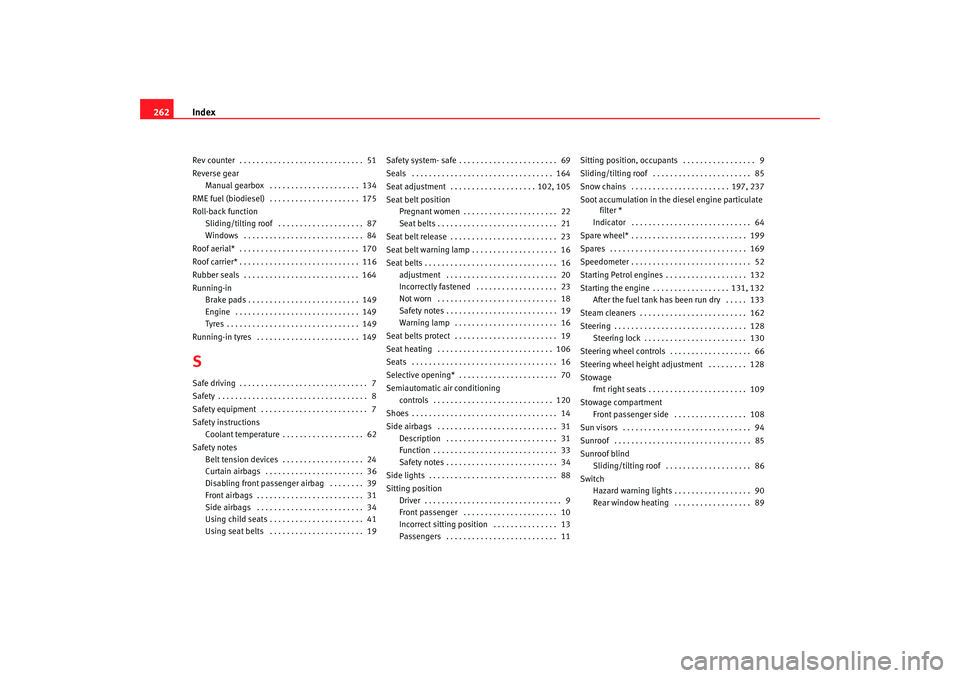
Index
262Rev counter . . . . . . . . . . . . . . . . . . . . . . . . . . . . . 51
Reverse gear
Manual gearbox . . . . . . . . . . . . . . . . . . . . . 134
RME fuel (biodiesel) . . . . . . . . . . . . . . . . . . . . . 175
Roll-back function Sliding/tilting roof . . . . . . . . . . . . . . . . . . . . 87
Windows . . . . . . . . . . . . . . . . . . . . . . . . . . . . 84
Roof aerial* . . . . . . . . . . . . . . . . . . . . . . . . . . . . 170
Roof carrier* . . . . . . . . . . . . . . . . . . . . . . . . . . . . 116
Rubber seals . . . . . . . . . . . . . . . . . . . . . . . . . . . 164
Running-in Brake pads . . . . . . . . . . . . . . . . . . . . . . . . . . 149
Engine . . . . . . . . . . . . . . . . . . . . . . . . . . . . . 149
Tyres . . . . . . . . . . . . . . . . . . . . . . . . . . . . . . . 149
Running-in tyres . . . . . . . . . . . . . . . . . . . . . . . . 149SSafe driving . . . . . . . . . . . . . . . . . . . . . . . . . . . . . . 7
Safety . . . . . . . . . . . . . . . . . . . . . . . . . . . . . . . . . . . 8
Safety equipment . . . . . . . . . . . . . . . . . . . . . . . . . 7
Safety instructions Coolant temperature . . . . . . . . . . . . . . . . . . . 62
Safety notes Belt tension devices . . . . . . . . . . . . . . . . . . . 24
Curtain airbags . . . . . . . . . . . . . . . . . . . . . . . 36
Disabling front passenger airbag . . . . . . . . 39
Front airbags . . . . . . . . . . . . . . . . . . . . . . . . . 31
Side airbags . . . . . . . . . . . . . . . . . . . . . . . . . 34
Using child seats . . . . . . . . . . . . . . . . . . . . . . 41
Using seat belts . . . . . . . . . . . . . . . . . . . . . . 19 Safety system- safe . . . . . . . . . . . . . . . . . . . . . . . 69
Seals . . . . . . . . . . . . . . . . . . . . . . . . . . . . . . . . . 164
Seat adjustment . . . . . . . . . . . . . . . . . . . . 102, 105
Seat belt position
Pregnant women . . . . . . . . . . . . . . . . . . . . . . 22
Seat belts . . . . . . . . . . . . . . . . . . . . . . . . . . . . 21
Seat belt release . . . . . . . . . . . . . . . . . . . . . . . . . 23
Seat belt warning lamp . . . . . . . . . . . . . . . . . . . . 16
Seat belts . . . . . . . . . . . . . . . . . . . . . . . . . . . . . . . 16 adjustment . . . . . . . . . . . . . . . . . . . . . . . . . . 20
Incorrectly fastened . . . . . . . . . . . . . . . . . . . 23
Not worn . . . . . . . . . . . . . . . . . . . . . . . . . . . . 18
Safety notes . . . . . . . . . . . . . . . . . . . . . . . . . . 19
Warning lamp . . . . . . . . . . . . . . . . . . . . . . . . 16
Seat belts protect . . . . . . . . . . . . . . . . . . . . . . . . 19
Seat heating . . . . . . . . . . . . . . . . . . . . . . . . . . . 106
Seats . . . . . . . . . . . . . . . . . . . . . . . . . . . . . . . . . . 16
Selective opening* . . . . . . . . . . . . . . . . . . . . . . . 70
Semiautomatic air conditioning controls . . . . . . . . . . . . . . . . . . . . . . . . . . . . 120
Shoes . . . . . . . . . . . . . . . . . . . . . . . . . . . . . . . . . . 14
Side airbags . . . . . . . . . . . . . . . . . . . . . . . . . . . . 31 Description . . . . . . . . . . . . . . . . . . . . . . . . . . 31
Function . . . . . . . . . . . . . . . . . . . . . . . . . . . . . 33
Safety notes . . . . . . . . . . . . . . . . . . . . . . . . . . 34
Side lights . . . . . . . . . . . . . . . . . . . . . . . . . . . . . . 88
Sitting position Driver . . . . . . . . . . . . . . . . . . . . . . . . . . . . . . . . 9
Front passenger . . . . . . . . . . . . . . . . . . . . . . 10
Incorrect sitting position . . . . . . . . . . . . . . . 13
Passengers . . . . . . . . . . . . . . . . . . . . . . . . . . 11 Sitting position, occupants . . . . . . . . . . . . . . . . . 9
Sliding/tilting roof . . . . . . . . . . . . . . . . . . . . . . . 85
Snow chains . . . . . . . . . . . . . . . . . . . . . . . 197, 237
Soot accumulation in the
diesel engine particulate
filter *
Indicator . . . . . . . . . . . . . . . . . . . . . . . . . . . . 64
Spare wheel* . . . . . . . . . . . . . . . . . . . . . . . . . . . 199
Spares . . . . . . . . . . . . . . . . . . . . . . . . . . . . . . . . 169
Speedometer . . . . . . . . . . . . . . . . . . . . . . . . . . . . 52
Starting Petrol engines . . . . . . . . . . . . . . . . . . . 132
Starting the engine . . . . . . . . . . . . . . . . . . 131, 132 After the fuel tank has been run dry . . . . . 133
Steam cleaners . . . . . . . . . . . . . . . . . . . . . . . . . 162
Steering . . . . . . . . . . . . . . . . . . . . . . . . . . . . . . . 128 Steering lock . . . . . . . . . . . . . . . . . . . . . . . . 130
Steering wheel controls . . . . . . . . . . . . . . . . . . . 66
Steering wheel height adjustment . . . . . . . . . 128
Stowage frnt right seats . . . . . . . . . . . . . . . . . . . . . . . 109
Stowage compartment Front passenger side . . . . . . . . . . . . . . . . . 108
Sun visors . . . . . . . . . . . . . . . . . . . . . . . . . . . . . . 94
Sunroof . . . . . . . . . . . . . . . . . . . . . . . . . . . . . . . . 85
Sunroof blind Sliding/tilting roof . . . . . . . . . . . . . . . . . . . . 86
Switch Hazard warning lights . . . . . . . . . . . . . . . . . . 90
Rear window heating . . . . . . . . . . . . . . . . . . 89
ibiza_angles_0706_DEF Seite 262 Freitag, 1. September 2006 1:18 13